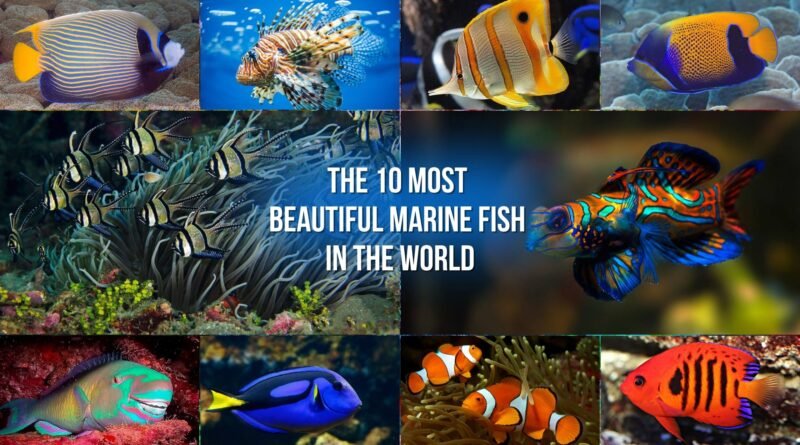The 10 most beautiful marine fish in the world
We are aware that the oceans are teeming with remarkable and formidable creatures: vast species of predatory fish, sharks, whales, giant octopuses, and numerous other majestic and enigmatic animals that inhabit the waters, enhancing their beauty. However, there exists another kind of beauty, a more delicate one, found in smaller marine creatures – fish with vibrant and dazzling colors. In this article, we will acquaint ourselves with some of these captivating beings. We have handpicked 10 marine fish that we believe will leave you impressed and delighted. Shall we meet them? Enjoy reading and have a great time!

Majestic angelfish (Pomacanthus navarchus)
There are more than 80 species of angelfish around 7 genera, all belonging to the Pomacanthidae family. Its main features are its oval and thin body, prominent but small mouth, spines on its fins, and dazzling colors.
The majestic angelfish is a species that inhabits coral reefs in the Pacific Ocean, preferring to stay close to caves and crevices, where, when young, it used to live hidden for protection.
They are relatively small fish, reaching a maximum length of 11.8 inches, and, as with most colorful fish, their colors become vibrant when they reach adulthood. The bright yellow, intense blue, and some almost neon blue stripes make it one of the most beautiful marine fish in existence.
Fortunately, the majestic angelfish is not yet an endangered species and is classified as Least Concern on the IUCN – International Union for Conservation of Nature’s Red List of Threatened Species.

Mandarinfish (Synchiropus splendidus) – saltwater fish
The mandarinfish is another example on the list of the most beautiful marine fish in the oceans, with its varied colors and patterns. It is a small fish, measuring, on average, 2.3 to 3.9 inches, and is found in the coral reefs of the Indo-Pacific.

The mandarinfish has large fins that resemble wings and swims so gracefully that it appears to be flying through the water. It does not have scales, but rather thick skin that protects it from being scratched while swimming around corals. Each fish has unique drawing patterns on its body, you will never see two mandarins the same. Fabulous, isn’t it?
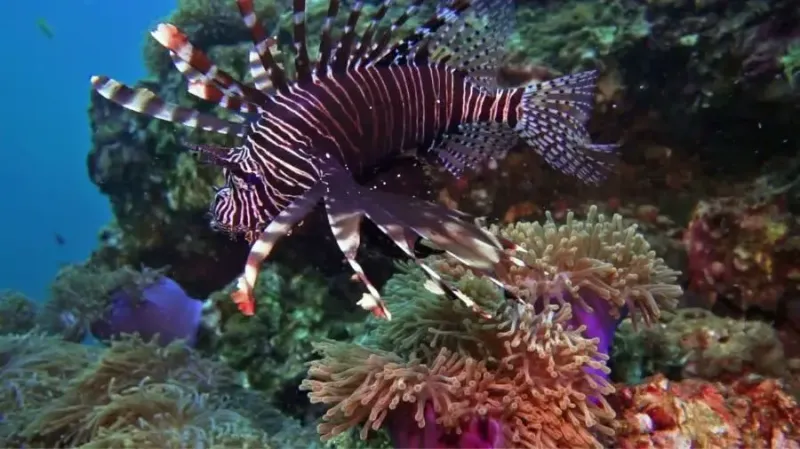
Lionfish (Pterois)
These magnificent marine fish also originate from the Indo-Pacific region and live in coral reefs. It has an exotic beauty, with specimens of varied colors and patterns, and its huge fins look like wings. Despite so much beauty, they are poisonous fish, they have 18 spines with toxins that they use for protection and food, a diet that includes other fish, crustaceans, and shrimp. Yes, they are carnivores and within 30 minutes they are capable of eating up to 20 other fish and invertebrates.
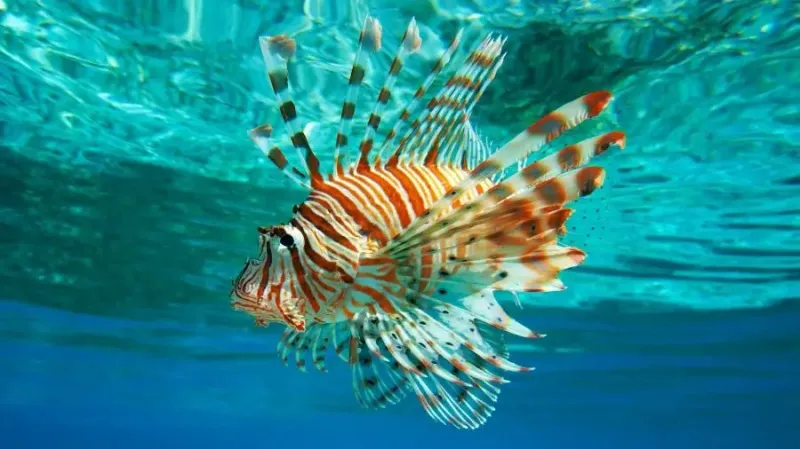
Much sought after by saltwater fish aquarists, lionfish are currently considered an invasive species in several parts of the world, and this poses a very high risk to biodiversity. The greatest risk is due to the fact that, in places where it is not its original habitat, the lionfish has no natural predators, being able to drastically reduce the number of fish in the area, affecting fishing, tourism, and the balance of the ecosystem.

Copperband butterflyfish (Chelmon rostratus)
In total, there are 115 species of butterflyfish, belonging to the Chaetodontidae family, and the Copperband butterflyfish (Chelmon rostratus) is one of the 3 representatives of the genus Chelmon, whose main feature is its elongated mouth, similar to a beak. It’s like that, with that beak.
They are found on reefs in the Pacific and Indian Oceans, very active during the day, but they spend the night hiding in crevices as protection, after all, they are delicious snacks for sharks, eels, and other larger fish. When they feel threatened or irritated, the colors of their little bodies become brighter, and during the night, to camouflage themselves more easily among the corals, their colors decrease in tone. The conservation status of the Copperband butterflyfish (Chelmon rostratus) is of least concern, it is not endangered.♥

Clownfish (subfamily Amphiprioninae)
Do you remember the fish from Finding Nemo? You agree that it’s the cutest thing, right? Clownfish live their entire lives with just one partner, inside poisonous anemones, and the interesting thing is that this poison is harmless to them due to a substance that the fish produces in its body and protects it from toxins. In fact, the relationship between the clownfish and the anemone is what biology calls symbiosis: a relationship between living beings in which one benefits from the other (in fact, there are relationships in which only one of the living beings has an advantage).
All clownfish are born male and, depending on the school’s need for reproduction, they may or may not transform into females. This sequential hermaphroditism is called protandry and its main function is to guarantee the reproduction of the species. They are small fish found in the Pacific and Atlantic oceans and, fortunately, are not endangered.
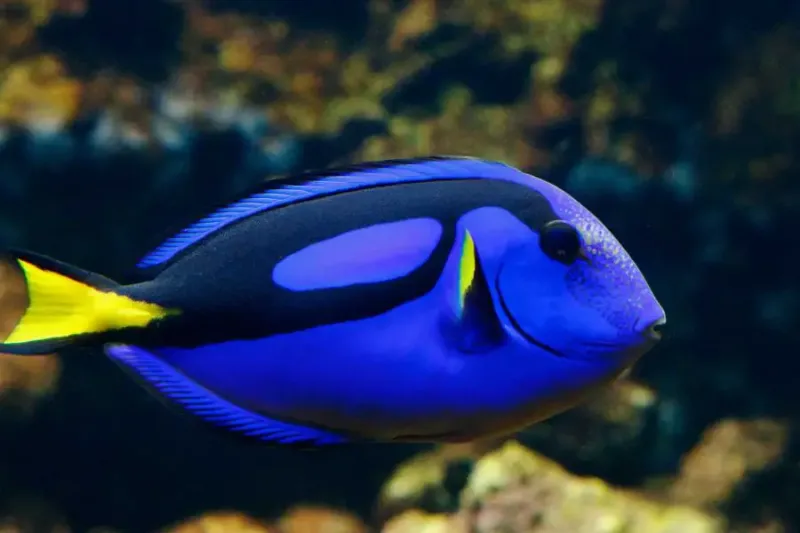
Palette surgeonfish (Paracanthurus hepatus)
And while we’re talking about Finding Nemo, we have to admit that the clownfish’s crazy friend, Dory, is also beautiful, with her vibrant blue, yellow, and black colors. Just like the butterflyfish we talked about above, there are different types of surgeonfish. They are part of the Acanthuridae family, which has around 80 species, however, the palette surgeon is the only one of the genus Paracanthurus within this family.
They grow up to 11.8 inches, are considered medium-sized fish, and, on their tail fin, they have a kind of toxic blade, in pairs, which they use to defend themselves. On the upper and lower part of their little body, they have spines similar to scalpels and perhaps this is where the idea for the name “surgeon” came from. They feed basically on plankton and seaweed and are found in the Indian and Pacific Oceans.

Banggai Cardinalfish (Pterapogon kauderni)
The list of fascinating saltwater fish that fill our eyes with so much beauty is long, and we couldn’t leave out the Banggai cardinalfish. They originate from Indonesia, in the Banggai region, hence their name, and in addition to their elegant and captivating appearance, which enchants aquarists all over the world, the cardinalfish is also famous for its fascinating behavior. They live in groups of up to 500 members, with strong social interaction and care between individuals in the school. The males carry the fertilized eggs in their mouths until the young are ready to hatch, thus demonstrating impressive parental zeal.
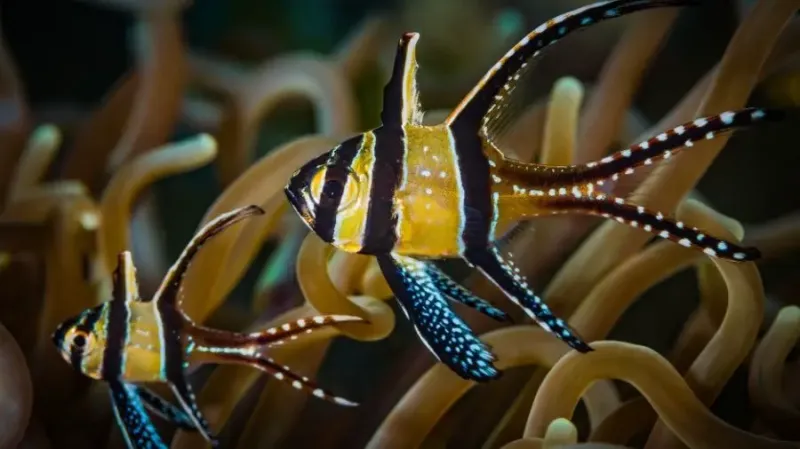
Unfortunately, due to excessive fishing and capture for the aquarium trade and the degradation of its habitat, this small fish measuring approximately 3.1 inches is endangered.
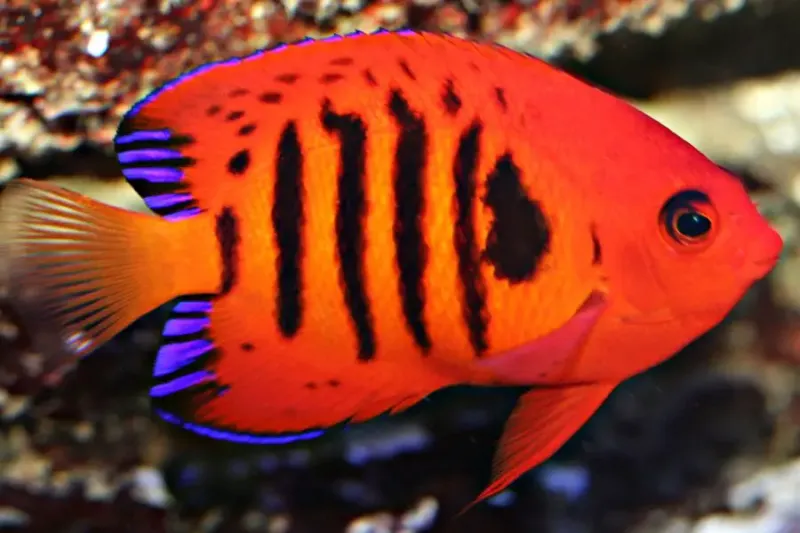
Flame angelfish (Centropyge loricula)
The color of this little marine fish resembles a flame of fire, hence its name. Its vibrant color in shades of orange or red makes it one of the most stunning saltwater fish in existence and for this reason, it is highly appreciated by aquarists around the world. Its small, elongated oval body has 3 to 7 vertical black stripes, and in terms of size, it does not exceed 5.9 inches.
The origin of the flame angelfish species is in the Pacific Ocean and they are found in coral reefs and adjacent areas, where they find shelter and food. Fortunately, they are classified in the Least Concern category in relation to their conservation status.
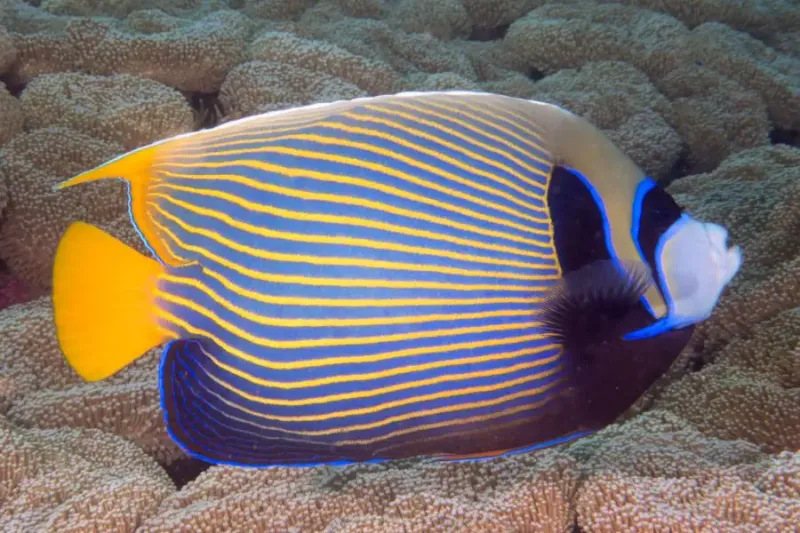
Emperor angelfish (Pomacanthus imperator)
This species of impressive and majestic beauty originates from the Indian and Pacific Oceans and also inhabits coral reefs. They are very active animals, however only during the day, as at night, they hide to protect themselves from predators. Their stunning coloration differs depending on their life stages, when they are young they are different from when they are adults. Their elongated body can measure up to 15.7 inches. They are territorial fish and like to swim in open areas close to corals and reefs. They feed on seaweed, sponges, and small invertebrates from their reef neighbors.
Fortunately, its conversation status is considered Least Concern and its population is stable.
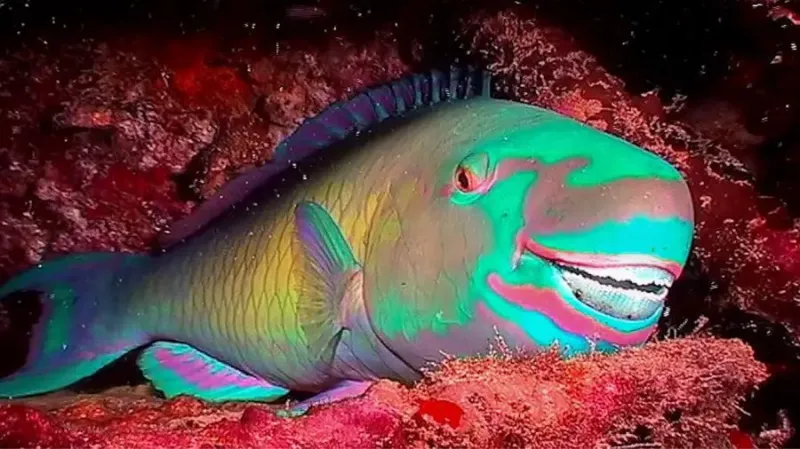
Parrotfish (family Scaridae)
Just like angelfish, there are also several species of marine fish parrotfish in the Scaridae family, totaling around 95 different ones, all equally beautiful. These saltwater fish originate from the Caribbean and tropical areas of the Atlantic Ocean. As adults, they can reach a length of up to 19.6 inches. Parrotfish are known for their vibrant and bright colors, and their teeth are shaped like a parrot’s beak, hence the name.
Parrotfish are a type of marine life that can change sex during their lifespan. They start as females and, depending on the needs of the school and the environment, they can transform into males to ensure successful reproduction of the species. This ability is one of the fascinating characteristics of these fish species.
Fortunately, parrotfish are not endangered and are classified as Least Concern. They play an important role in the health of coral reefs. As bottom-dwelling species, they help control algae growth by grazing on it. Additionally, their venomous spines protect them from predators.
When considering tank mates, it’s important to be cautious as parrotfish can be territorial and may exhibit aggressive behavior towards other species. However, with proper planning and a suitable environment, they can coexist peacefully with compatible tank mates.
Overall, parrotfish are captivating fishes that contribute to the diversity and beauty of marine ecosystems. Their presence enhances the vibrancy of coral reefs and reminds us of the wonders of the underwater world.
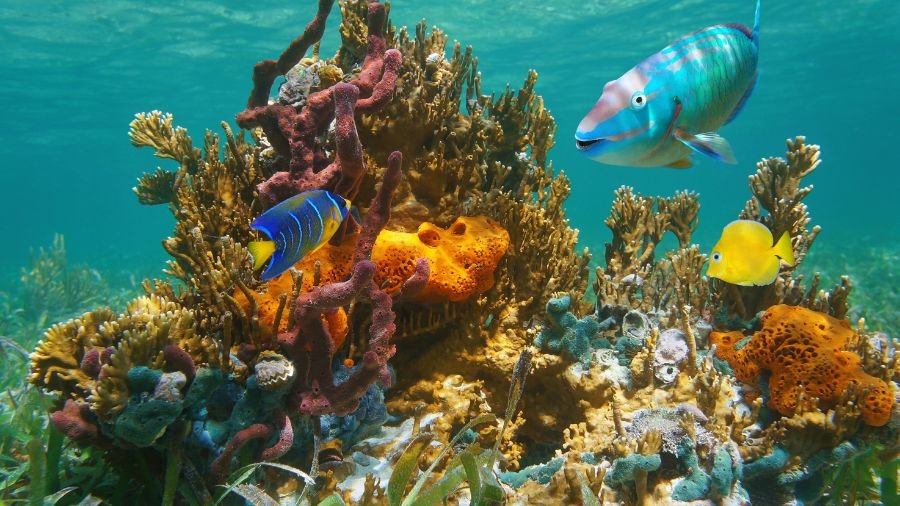
Final Thoughts on Saltwater Fishes
In this article, we have explored 10 captivating examples of saltwater fish that showcase the diversity and beauty found in the oceans and coral reefs. Each of these species, with their unique shapes and vibrant colors, serves as a reminder of the importance of preserving nature and conserving coral reefs. It is crucial, especially for fishkeeping enthusiasts, to ensure that these marine fishes are obtained from responsible sources to avoid unsustainable capture.
These marine fish play a vital role in maintaining the health and conservation of coral reefs, which are complex and unique ecosystems. They contribute to the overall balance and variety of species in the water, including sharks and various sizes of fishes.
We hope you have enjoyed learning more about these amazing fish! Until next time! ♥

